The Parts of the Piano
The many parts of the piano are constructed together to create a string instrument whose strings are struck by hammers and whose hammers are activated by keys.
The parts of the piano are held in place by the frame, made of wooden beams, which can be seen on the back of an upright, or the underside of a grand piano.
The frame is attached to the rim on a grand, and the case on an upright. The grand has an inner and outer rim. The soundboard sits on the shorter inner rim. Attached to the frame is the pin block, soundboard and cast iron plate.
The pin block is made of laminated hard wood, usually at least 5 layers. The steel tuning pins sit an inch and a half into the pin block, with the perpendicular laminated grain holding the pin tightly.
The soundboard is usually sitka spruce, 3/8" thick, shaped to be concave with a "crown." This crown creates a diaphragmatic soundboard with tension that makes a tighter, louder tone.
On to the soundboard, one of the most important parts of the piano, are attached the hardwood bridges, where one end of the speaking length of the strings terminate, sending vibrations to the soundboard. The soundboard has hardwood ribs to give it more strength, and hold its shape.
The cast iron plate has the toughest job of the parts of the piano. It has to hold the piano together, under the pressure of about 230 strings creating around 18 tons of compression. The plate sits over the pin block, is attached securely to it, and has holes for the pins. The strings are hitched to the plate at the other end.
Grand Piano Cross Section
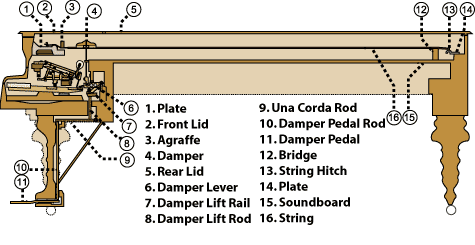
The piano strings are steel wire of varying thickness. The bass strings are made thicker and heavier with copper winding around the core string. The strings are held down for tension at the tuning end with a bearing bar (or pressure bar) on uprights, or agraffe on most grands (and some uprights).
The keyboard and action sit firmly on the keybed, large, thick wooden planks secure tightly to the frame.
Read more about the Piano Action....
The damper is a piece of felt that rests on the strings to mute the sound when the string is not being played. The high treble has no dampers, because the sound of these strings decays so quickly.
The Pedals
Most pianos have two pedals, and some have three. The pedal on the right is the sustain pedal, which activates a series of levers that raises all of the dampers.
The pedal on the left is the soft pedal on vertical pianos, which moves all of the hammers closer to the strings, thereby decreasing velocity and volume.
On grand pianos, the pedal on the left is called the una corda, which moves the whole action to the right, so the hammers strike only two of the three strings per note, thereby decreasing volume.
The third pedal on higher quality grand pianos is called the sostenuto pedal, which will sustain only the notes held prior to and while pushing down the pedal. This can act like a "third hand" for a player proficient in its use.
On lesser grands and some uprights the third pedal will sustain only the bass notes, a similar effect to the sostenuto.
On most uprights with three pedals, the middle pedal is usually a practice pedal. When depressed, this pedal moves a mechanism that drops a sheet of felt in front of the hammers, greatly decreasing the volume. Often these pedals can be "locked" in position, so the player does not have to hold it down.
Vertical Pianos
The exterior of an upright piano.
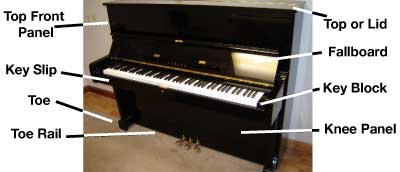
Cutaway of an upright showing the parts of the piano.
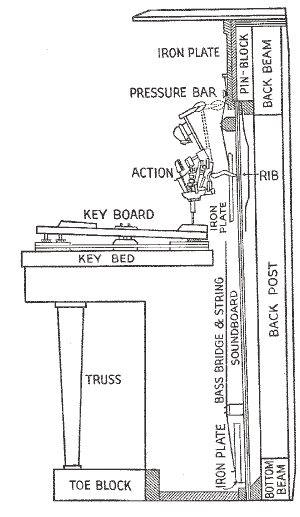
Cutaway of a spinet showing the parts of the piano.
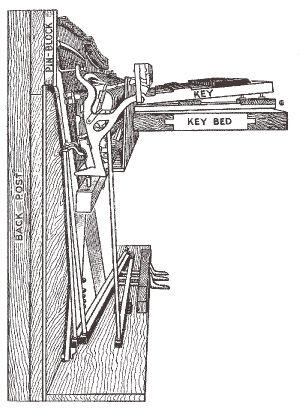
Start Playing Piano Today with the Piano Guide Quick Start Course!
Easy to follow step-by-step lessons designed for adult beginners. The next best thing to private lessons!
What You'll Learn:
- Notes on the piano/keyboard
- Proper fingering
- C major scale
- Chords
- How to read music
- And much more!
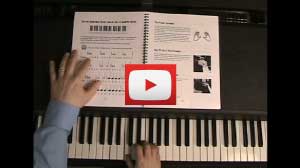
Video lessons - watch as I play everything for you.

